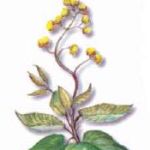| Common Name: |
Condor Vine |
| Other Names: |
Condurango, Eagle Vine |
| Botanical Name: |
Marsdenia cundurango syn. M. reichenbachii |
| Genus: |
Marsdenia |
| Family: |
Asclepiadaceae |
| Native Location: |
Columbia, Ecuador, Peru |
| Cultivation: |
Sandy, rich soil in partial shade. Cut back leading shoots after flowering to restrict growth and encourage production of laterals. |
| Propagation: |
By seed sown when ripe at 13-18°C (55-64°F); by semi-ripe cutting with a heel in summer; by layering during the growing season. |
| Harvest: |
Bark is beaten from the stems after drying and stored as liquid extracts, powders, or quills. |
| Height: |
9m (30ft) |
| Hardiness: |
Min. 15-18°C (60-65°F) |
| Parts Used: |
Bark |
| Properties: |
A bitter, slightly aromatic, acrid herb that improves appetite and digestion. It is regarded as an alterative and gastric sedative. |
| Medicinal Uses: |
Internally for anorexia, nervous dyspepsia, liver disorders, cancers of stomach and bowl. Combined with Acorus calamus (See, Sweet Flag), Chamaemelum nobile (See, Roman Chamomile), Chelone glabra (See, Turtlehead), Gentiana lutea (See, Gentian), and Humulus lupulus (See, Hops) for anorexia. Externally for warts. |
| Bibliography: |
Encyclopedia of Herbs by Deni Brown Copyright © 1995, 2001 Dorling Kindersley Limited Pg 272 |

